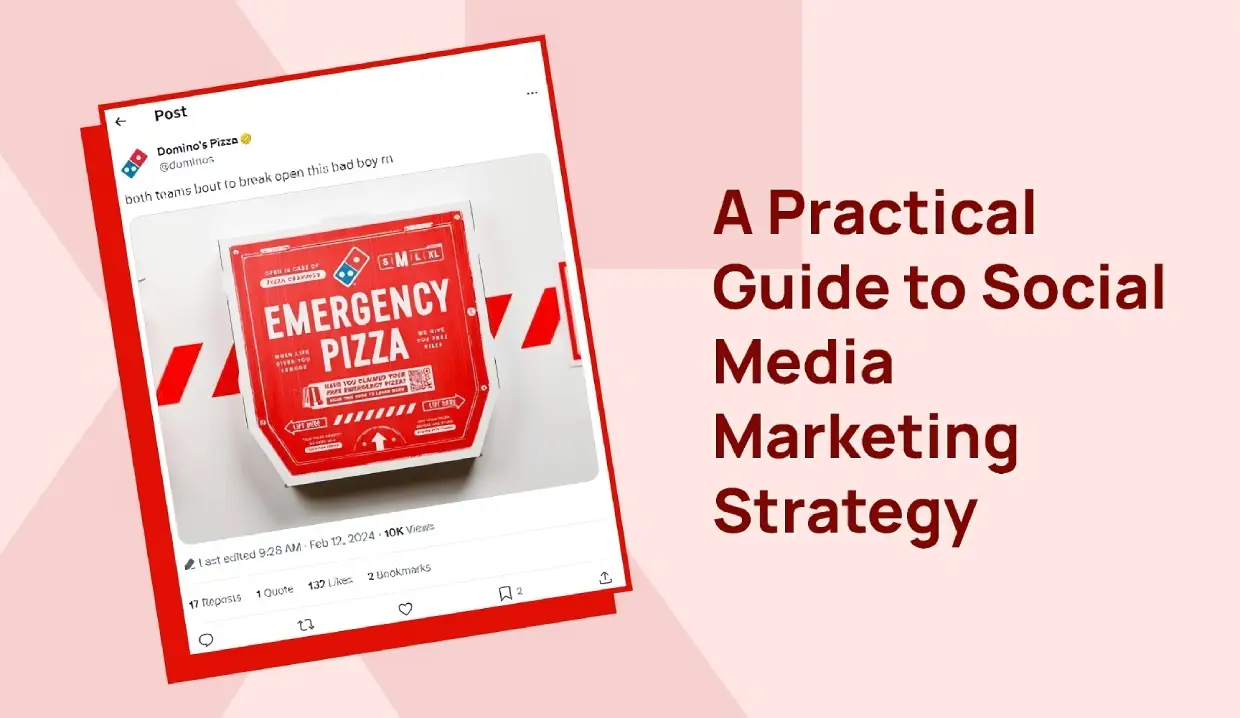Social media marketing strategy
Pixbrand Team
Published: 13/02/2024
- App Development
- Digital Marketing
- Ecommerce
- Seo
- shopify
- UI/UX Design
- Web Development
- woocommerce

Social media marketing. What is it?
The strategic use of social media channels to sell a product or service is known as social media marketing. To drive traffic, raise brand awareness, and produce leads or sales, entails utilizing various platforms to interact with and engage target consumers.
There are numerous ways to present this content, such as through text postings, pictures, videos, infographics, and more. The intention is to draw viewers in and motivate them to engage with, share, or act upon the content.
The best part of social media marketing is its power to allow open connections between audiences and brands. Real-time interaction and response are possible on social media, compared to traditional methods of advertising, which tend to be one-sided.
Direct communication allows brands to answer questions, address concerns, and develop bonds with consumers that promote trust and loyalty.
How to create a successful Social media marketing strategy
To create a successful social media strategy includes your business goals, target audience, right platform, content strategy, engaging content, and performance analysis.
Following these easy steps Will help you to craft a tailored social media strategy according to your business needs.
Define your business goals
Defining your business goals involves clearly articulating what you want to achieve within your organization. These goals serve as the foundation for your business strategy and guide decision-making processes.
Common business goals may include increasing revenue, expanding market share, improving customer satisfaction, enhancing brand visibility, launching new products or services, reducing costs, or achieving operational efficiency.
By setting specific, measurable, attainable, relevant, and time-bound (SMART) goals, you can focus your efforts, track progress, and align your team toward achieving success.
Find your target audience
Finding your target audience involves identifying the specific demographic, psychographic, and behavioral characteristics of the people most likely to be interested in your products or services.
This includes factors such as age, gender, location, income level, education level, interests, hobbies, values, attitudes, lifestyle preferences, purchasing behavior, and online habits.
To find your target audience, conduct market research using various methods such as surveys, interviews, focus groups, and data analysis.
Look at existing customer data, social media insights, website analytics, and industry reports to gain insights into who your audience is and what motivates them.
Once you have a clear understanding of your target audience, create buyer personas or profiles that represent your ideal customers. These personas help you visualize and empathize with your audience, allowing you to tailor your marketing messages, products, and services to meet their needs and preferences.
Continuously monitor and refine your understanding of your target audience as market conditions change and your business evolves. By staying connected to your audience and adapting to their needs, you can effectively engage them and drive business growth.
Conduct a social media audit
Conducting a social media audit is similar to performing a check-up on your social media presence to assess its overall health. Here’s how to do it:
Next, take a look at the content you’ve been posting. Is it interesting and relevant to your audience? Check how many likes, comments, and shares your posts are getting to see what’s working and what’s not.
Check your audience’s growth after that. Over time, are you gaining more and more followers? Keep an eye out for any significant shifts in interaction, such as a rise or fall in the number of likes and comments.
You monitor your competitors, To get some ideas. See what kinds of posts they are making and how their audience is reacting.
Use the analytics tools offered by social media to collect additional information about your performance. This may help you in understanding aspects such as the structure of your audience and their interactions with your content.
After completing all of that, you will know more about what is working well and what needs to be improved.
Choose the right platforms
Remember, Larger, more established brands typically have a presence on several different platforms. Large companies with the means to be everywhere at once, like Netflix and Domino’s, are more likely to exist, but what about mid-sized or small businesses? Also, not every social media network makes sense for your brand, even though there are so many of them. To help you decide where to focus your efforts, here’s a summary of the main social media platforms:X(formerly known as Twitter)

For most businesses, X is an excellent place to start because it’s easy to use, requires little setup, and allows direct communication with followers.
It’s no wonder that X is still one of the most popular platforms for customer service. If you’re looking to learn the fundamentals of social media marketing, such as hashtags, tagging, brand voice, and social media etiquette, look no further.
Instagram is primarily a visual content-focused network. The platform, which serves as a significant nexus for influencers, e-commerce stores, and physical companies alike, promotes brand creativity.
Whether it’s visually striking images or witty phrases, the key is coming up with original methods to showcase your products.

Facebook is necessary if you want to target customers locally. With check-ins and feedback accepted, this is a great spot to develop a loyal local following.
Additionally, they have amazing chatbot capabilities that may elevate your marketing and customer support initiatives.

LinkedIn is a network that is focused on networking and business trends. LinkedIn is a treasure, particularly for business-to-business (B2B) networking. If you are trying to connect with a CEO, marketing manager, or influencer? You can likely locate them here.
Threads

Threads, a text-based social network, using their existing Instagram account. Though Threads can be accessed on a PC, users can also post on mobile devices. Because it’s easy to sign up, Threads are a wonderful option for brands with existing Instagram profiles.

Pinterest is incredibly popular, especially among Millennials and Generation Z. Every month, over 465,000,000 users use this visual pinning tool to get ideas for their future purchases.
One of the greatest networks for social selling is said to be Pinterest. Similar to Instagram, Pinterest is fueled by pictures and motivational material, with merchandise acting as the page’s literal focal point.
YouTube

YouTube and its vibrant community on the site says volumes. If you are already creating videos, YouTube is a terrific place to host them since they are the most popular kind of material on almost all social networks.
Which one to choose?
Your brand can use over 14 different social media sites, but be careful not to overextend yourself. You should think about which platforms make the most sense for your business and target audience rather than trying to dominate them all.
Create a content calendar
Creating a content calendar is like making a schedule for what you’re going to post on social media and when. Here’s a simple way to do it:- Choose a format: Decide how you want to organize your content calendar. You can use a spreadsheet, a calendar app, or even a physical planner.
- Pick your platforms: Decide which social media platforms you want to post on. You might choose Facebook, Instagram, Twitter, LinkedIn, or others depending on where your audience is.
- Plan your content: Decide what kinds of posts you’re going to make and when you’re going to post them. You might have different themes for different days of the week, like “Motivation Monday” or “Throwback Thursday.”
- Schedule your posts: Use the scheduling tools provided by the social media platforms or third-party apps to schedule your posts in advance. This way, you can set it and forget it!
- Leave room for flexibility: While it’s good to have a plan, it’s also important to be flexible. Leave some space in your content calendar for timely or spontaneous posts that might come up.
- Review and adjust: Regularly review your content calendar to see how your posts are performing and adjust your strategy as needed. Pay attention to things like engagement metrics and feedback from your audience.
Engage with your audience
Engaging with your audience on social media is crucial for building relationships and fostering loyalty. Here’s how:- Respond to comments: Acknowledge and reply to comments on your posts.
- Initiate conversations: Start discussions by asking questions or seeking opinions.
- Use interactive features: Utilize polls, quizzes, and contests to encourage participation.
- Share user-generated content: Highlight content created by your audience.
- Personalize interactions: Address audience members by name and tailor responses.
- Be authentic: Maintain genuineness in your interactions and avoid overly promotional language.
- Monitor conversations: Keep track of discussions related to your brand or industry.
- Respond promptly: Aim to reply to inquiries and messages on time.
Leverage influencer marketing.
Leveraging influencer marketing involves collaborating with individuals who have a significant following and influence on social media to promote your brand.
To do this effectively, start by identifying influencers whose audience aligns with your target demographic and whose values match your brand.
Build relationships with them by engaging with their content and showing genuine interest in their work.
Once you’ve established rapport, collaborate on content that resonates with your audience while subtly promoting your brand.
Set clear expectations, track the performance of your campaigns, and adjust your strategy as needed based on the results.
Foster long-term partnerships with influencers who deliver positive outcomes and ensure transparency and authenticity in all collaborations by disclosing sponsored content.
By leveraging influencer marketing, you can expand your brand’s reach, credibility, and engagement with your target audience effectively.
Leverage influencer marketing.
Here are five additional tips to enhance your social media strategy:
- Consistency is Key: Maintain a consistent posting schedule to keep your audience engaged and build brand awareness. Regular, timely posts help to stay top-of-mind with your followers and demonstrate your commitment to providing valuable content.
- Visual Appeal Matters: Incorporate eye-catching visuals, such as high-quality images, videos, and graphics, into your posts to capture attention and increase engagement. Visual content tends to perform better on social media and can help convey your brand message more effectively.
- Utilise Hashtags Strategically: Research relevant hashtags related to your industry, content, or campaigns, and incorporate them into your posts to increase discoverability and reach a wider audience. However, avoid overloading your posts with hashtags, as this can come across as spammy.
- Foster Community Engagement: Encourage interaction and conversation among your followers by posing questions, soliciting feedback, and responding to comments and messages promptly. Building a sense of community around your brand can lead to increased loyalty and advocacy among your audience.
- Stay Updated with Trends: Keep abreast of current trends, topics, and hashtags in your industry and on social media platforms. By staying relevant and participating in trending conversations, you can capitalize on opportunities to expand your reach and connect with a broader audience.
Conclusion
In conclusion, crafting a successful social media strategy requires careful planning, consistent execution, and continuous refinement.
By understanding your audience, setting clear goals, creating compelling content, and engaging authentically with your followers, you can build a strong presence and drive meaningful results on social media.
Additionally, leveraging influencer partnerships, monitoring performance metrics, and staying updated with industry trends is essential for staying competitive and maximizing your impact. Remember that social media is a dynamic and ever-evolving landscape, so be flexible and adaptable in your approach, and always be willing to experiment and iterate based on insights and feedback.
With dedication, creativity, and strategic thinking, you can effectively leverage social media to achieve your business objectives and foster meaningful connections with your audience.